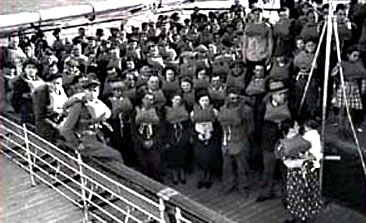Italian immigrants in Comodoro Rivadavia See map
Comodoro Rivadavia, since its inception, was linked to Italian immigrants. The need for an output port for agricultural products like it is today Sarmiento, made Francisco Pietrobelli explore the region since 1897 and decided on a place 10 kilometers from Rada Tilly.
 Hundreds of italians came to Comodoro although they were not the largest inmigrant group that arrived in the city.
Hundreds of italians came to Comodoro although they were not the largest inmigrant group that arrived in the city.After the port was used as a boarding area and decrease in merchandise in 1901, the Executive officially founded the town of Comodoro Rivadavia.
Pietrobelli had come north of Chubut (Puerto Madryn) in 1888 along with other fellow to work on the railway works of Chubut. Then he associated with a group of Welsh to explore and colonize the valleys of the Andean regions. This was traveling the province to the port for consolidation of their interests.
Graciela Ciselli regional historian explains that "with the discovery of oil is produced the first great wave of Italian immigrants."
Contrary to what you might guess, the immigrants that came weren't in poverty and misery, as these same circumstances would preclude the purchase of passenger boarding.
"The reasons lie in the instability of Italian politics, class differences and fear of war. At that time the Austro-Hungarian dispute with Italy's northern peninsula," says Ciselli.
Another important moment in the Italian immigration to Comodoro Rivadavia extends between 1947 and 1960. The government of President Perón pushed an immigration policy that was overflowing by the number of European travelers.
The postwar period prompted many workers, including professional-technical level to leave their home countries because of the high unemployment and crises of all kinds that were in Europe.
Since the beginning of the century the Italians were related to trade and skilled jobs. While large commercial houses like Lahusen and La Anónima dominated the region, some immigrants were associated with them as managers and business managers.
Around 1920 the Italian immigrants were the third set of numerical importance, after the Spanish and Argentine.
"However, we know that hundreds of Italians arrived, though not as much as is sometimes assumed knowing that, in general, is less than fourth in quantity, unlike other areas of the country as Buenos Aires and Santa Fe, where they form the majority group", says Ciselli.
Viajes por la Patagonia
Related Articles
© Patagonia.com.ar 2025 | Todos los derechos reservados.
